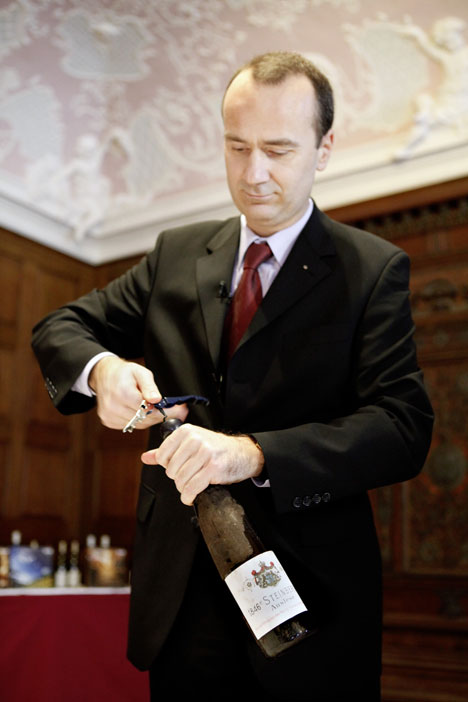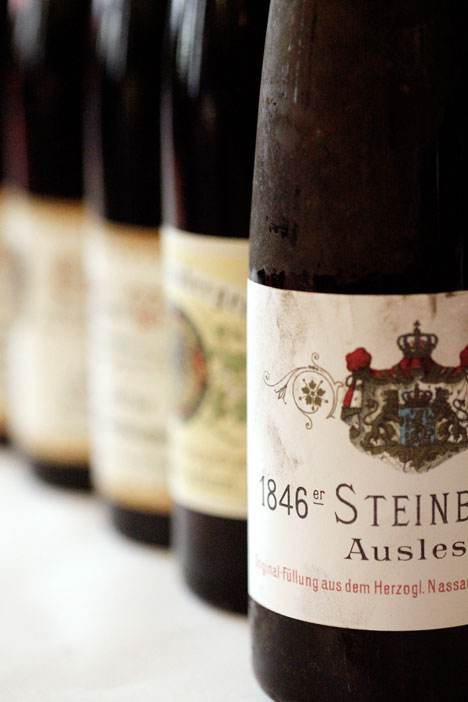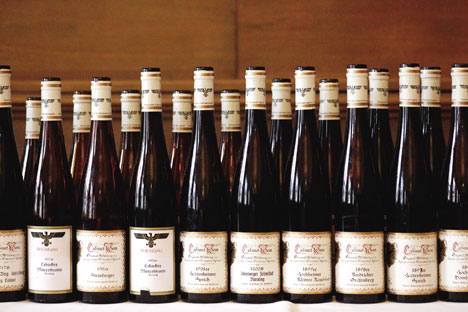Historical wines within ancient walls: The state wineries Kloster Eberbach, the wine magazine "FINE" and the VdP invited around 20 guests to the Rhine to taste 100 vintages of Riesling between 1846 and 2009. They wanted to show the storage capacity of German Riesling from dry to noble sweet. The result: "Grandiose top wines," was how star winemaker Wilhelm Weil assessed the flights.

Dieter Greiner looks a little nervously into the television cameras and lenses of the photographers. He carefully places the corkscrew on the neck of the bottle. His other hand grips the bottle, whose label reads "1846er Steinberger Auslese" and below it "Originalfüllung aus dem Herzogl. Nassauischen Cabinets-Keller". The managing director of the Hessische Staatsweingüter Kloster Eberbach routinely pulls out the cork and smells it: "No cork, for once," he says to the photographers and cameramen.He smiles tensely. Greiner pours a tiny sip into the waiting glass while the cameras approach and flash. Greiner smells, tastes. His concentrated gaze relaxes. "Beguiling freshness. Dry fruit. Harmony!" Greiner beams and is silent for a moment. Finally he calls out in the direction of the lenses and applauding guests, "History! A Riesling from the time before the German Revolution!"
Highlight of a century-long tasting: the 1846 Steinberger Cabinet
The opening of the 1846-er Steinberger was the highlight of a century-long tasting of Riesling rarities in the deep snow-covered former Cistercian monastery in the Rheingau. The organisers of the event - the wine magazine FINE, the state wineries Kloster Eberbach and the VdP - meant it literally. Under the ornate stucco ceiling of the monks' refectory, around 20 journalists, wine critics, vintners and experts tasted 100 vintages of Riesling from the years 1846 to 2009. This tasting was "a small world sensation", emphasised Ralf Frenzel, owner of the Tre Torri publishing house and FINE editor. There are "only very few estates in the world that have a wine archive that even comes close to the scope and depth of the treasure chamber of the Eberbach monastery." And so the guests - among them critics Jancis Robinson and Stuart Pigott, winemaker Wilhelm Weil, star chefs Hans Stefan Steinheuer and Michael Hoffmann ("Margaux", Berlin) as well as ex-sommelier world champion Markus del Monego - embarked on a two-day journey into the living history of Riesling.

The organisers of the tasting had deliberately opened not only the top vintages, but also "wines from middle and disaster years" to explore the diversity of the development of Riesling wine, Frenzel explained. "Some sweet wines come from vintages of the 1970s that are now considered undrinkable," he explained the concept, "but the tasting proves that interesting wines with storage potential were also created during this period." For example, the deep brown 1973 Steinberger Eiswein Beerenauslese with concentrated aromas of fireplace, ash, antique wood and dark honey exuded a wonderful warmth that was contrasted well by fresh acidity. Incidentally, Dieter Greiner assessed the following flight of eight Trockenbeerauslese from 1969 to 1920 with a current auction value totalling 40,000 euros.
Seven dry Rieslings from the 19th century
A special aspect of the rarity tasting was the array of dry Riesling, which, with 23 wines, reached back to 1896. The "Cabinet" wines, whose designation in the monastery denotes the best of a year, even reached deep into the 19th century with seven wines - all the way back to 1846-er. "Grandiose and highly interesting," was how Wilhelm Weil, chairman of the VDP Rheingau, assessed the flights of dry wines. His three favourites all came from this category: the elegant 1917-er Rüdesheimer Berg Schlossberg Cabinet with notes of coffee, sherry, some pepper and, petrol, the 1900-er Steinberger Cabinet with aromas of macademia nuts, cake dough and baguette as well as the deep brown 1893-er Neroberger Cabinet, which offered delicately elegant aromas of coffee, caramel, chocolate truffle and chocolate with fine acidity. Tasting the 1898-er Kiedricher Gräfenberg was particularly interesting for him - as this vineyard has now been in his possession for many years. "I have more than just a respectful attitude towards these wines. There is life in them - and much more than I ever expected," Weil explained, still enthusiastic about the impression of the wines.
Markus del Monego also summed up: "This freshness despite great age is phenomenal." He was particularly impressed by "the massive concentration of exceptional wines" in the flights - but also that the "secondary vintages were integrated": "This is the only way to understand the development of the estate based on the historical processes."
Riesling expert Jancis Robinson said the tasting had confirmed her view "that Riesling is the best of all white wine varieties." She awarded 19.5 out of 20 points no less than six times, she tells us, pausing to count on her laptop and wondering a little about the number, which is high for her: "Because I'm very, very cautious with ratings of 19 points or more." The 1898 Kiedrich Gräfenberg was one of them. She, too, was amazed at "what good condition" the old wines were in. Robinson tasted "20-20 wines", she smiles: "Best drunk 1920 to 2020". One of her favourites was a 1915 Erbacher Marcobrunn Cabinet, which was surprisingly fresh, present and elegant with notes of sherry and coffee, along with lush length.

"Lots of bouquet, steely and spiritual." "Elegant, fine and highly ripe." These assessments of the 1846 Steinberger Cabinet, which Dieter Greiner opened in front of the television cameras, were already published in a book between 1888 and 1892. At that time, the wine was already around 45 years old. The court counsellor Dr. Conrad Schmitt had also had it analysed: According to this, it had only 7.3 percent alcohol and about six grams of acidity. And 2010? Glasses clinked as the wine was poured. For the wine, which had evaporated over the years, was refilled by the guardians of the wine treasure with glass balls. And indeed: freshness! A somewhat indifferent nose of antique wood and a hint of candied fruit, on the palate full-bodied, present notes of coffee and sherry with good length. At least for a few minutes. After about an hour, the Steinberger floated very slowly into vinological nirvana with aromas of smoke and vinegar. The tasters, sitting at the table with by now more than 500 glasses in front of them, applauded it once more. Now there are only two bottles of Steinberg left in the treasure chamber. By the way, it is not the oldest wine stored there. Perfectly stored and cared for, it dates back to 1706, a Riesling from the time before the French Revolution.